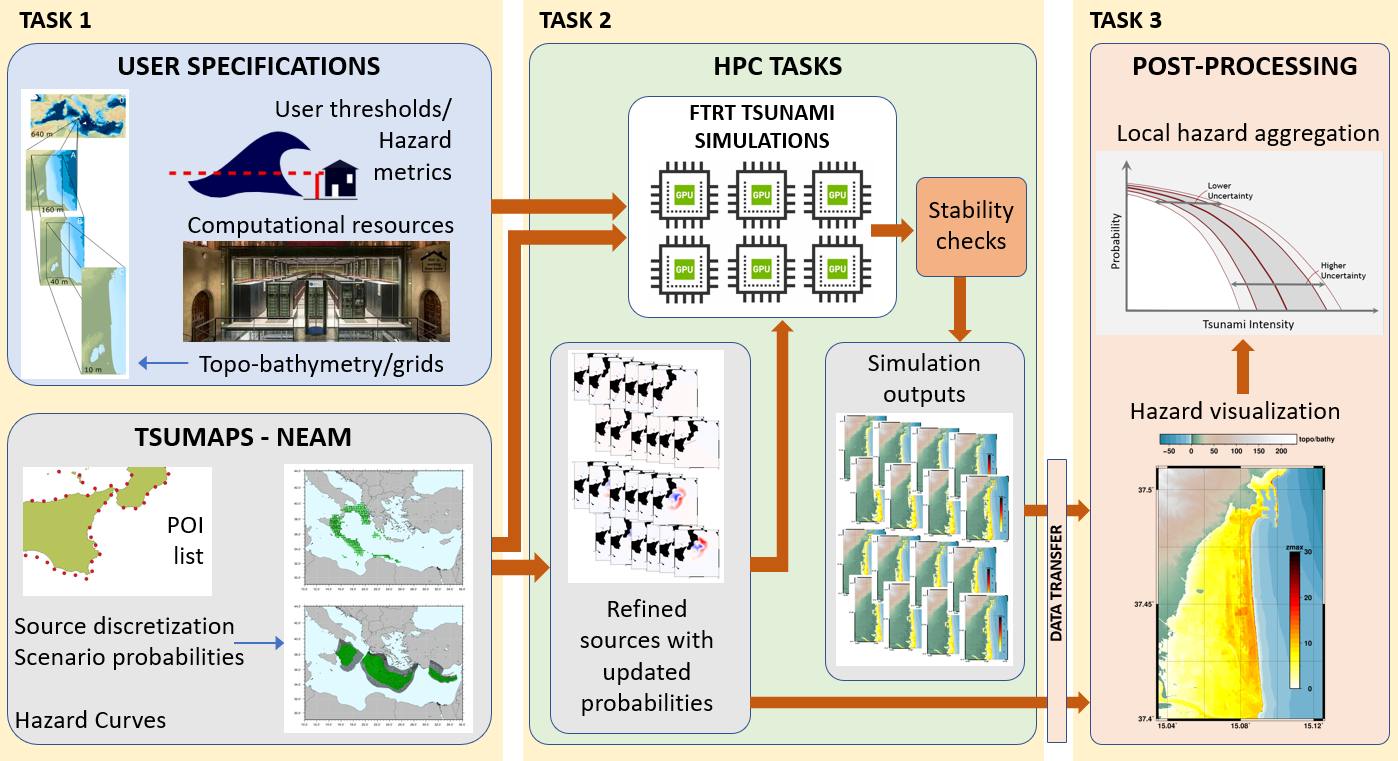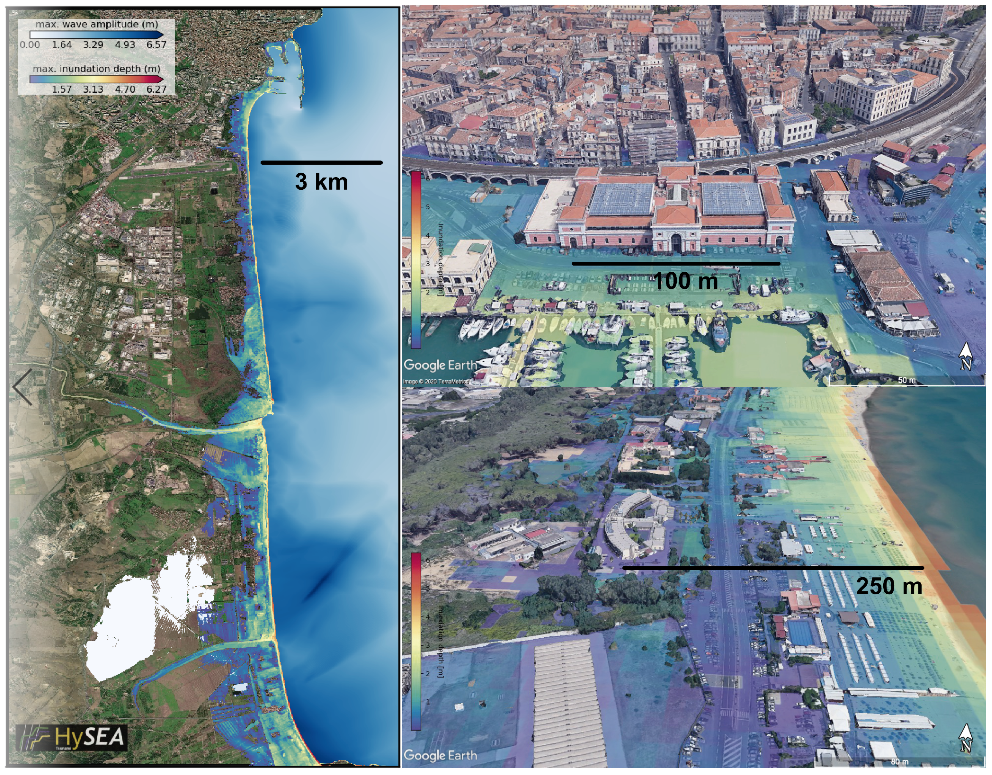| Main objective / mission |
This Pilot Demonstrator PD7 uses Tier-0 HPC resources to provide Probabilistic Tsunami Hazard Analysis (PTHA), which quantifies the probability of exceeding a specified inundation height, as well as other hazard intensities. PTHA provides scientific guidance for tsunami risk analysis and risk management, including coastal planning and early warning. PTHA aggregates the hazard from many discrete potential scenarios considering their individual probabilities. The objective of the present pilot demonstrator is to provide explicit computation of site-specific PTHA covering a domain of a city scale, say, using a high number of earthquake tsunami source scenarios, combined with high-resolution numerical inundation modelling. The PD7 is linked to applications in the Mediterranean Sea, and uses input data from an existing regional assessment (TSUMAPS-NEAM), to form the basis for the local hazard analysis. |
| Workflow description |

The employed PTHA workflow is shown above. We note that the processes carried out inside the Tier-0 system are shown inside the green box. In brief, the workflow contains the following main steps:
(1) Preparation of input data, including user specifications and data retrieval from TSUMAPS-NEAM. This includes high resolution bathymetry and topography data, hazard related thresholds, Tier-0 computational requirements, physics-related input, and data from the previous TSUMAPS-NEAM assessment.
(2) HPC workflow for the hazard analysis including high-resolution numerical tsunami simulations in the Tier-0 queue system using a Faster-Than-Real-Time (FTRT) micro-workflow, individual stability checking and removal of spurious results and data reduction algorithms for the individual out fields from the single simulation results.
(3) The aggregation of the hazard and visualisation. This is performed outside the Tier-0 system. |
| PD configuration |
Test case conducted for the tsunami hazard in Catania using a total of 32363 earthquake scenarios, using a system of nested grids with 10m-spacing at the finest resolution. A complete Tsunami-HySEA tsunami simulation for Catania with the grid system presented here took approximately 25 minutes on the MARCONI-100 supercomputer at CINECA, meaning that approximately 13600 GPU hours are required to complete the set of scenarios selected. With 1024 simulations able to run in parallel, around 14 hours of clock-time are needed to perform these calculations. |
| Tested architectures |
The software has been tested on four Tier-0 supercomputers: the CTE-POWER cluster in the Barcelona Supercomputing Center (BSC), DAVIDE cluster at CINECA consortium, on Marconi-100, and Piz-Daint at the Swiss National Supercomputer Center. CTE-POWER has 4 Tesla V100 cards per node, while DAVIDE has 4 Tesla P100 in each node and Piz-Daint has only 1 Tesla P100 in each node, while Marconi-100 has 4 V100 GPUs on each node. |
| Target TRL |
5-6
View TRL chart
|
| Relevant stakeholders |
Relevant stakeholders include, but are not limited to, national and local authorities responsible for managing risks from natural hazards, the insurance and re-insurance industry, owners of industrial installations or critical coastal facilities, and researchers in geoscience and natural hazard mitigation. |
| Achievements up to M41 |
The main achievement of ChEESE PD7 has been to perform local Probabilistic Tsunami Hazard Analysis (PTHA) efficiently using Tier0 HPC resources, raising the bar on the accuracy and resolution possible. We have done this in two steps. Firstly, by producing a landmark set of high-resolution tsunami hazard maps for Catania using a total of 32363 earthquake scenarios. Secondly, through the PRACE project TsuHazAP, this source resolution has been increased greatly with several hundreds of thousands of earthquake scenarios representing the hazard for a single site. The TsuHazAP simulations exploit the full functionality of the PD7 workflow and allow for a far finer source discretisation than has been available before, extending previous investigations by orders of magnitude. For each of the earthquake sources, a high-resolution tsunami simulation is carried out with inundation modelled at a resolution of 10m x 10m. The PTHA results, comprising almost 2 million individual inundation simulations for eight different sites in the Mediterranean Sea, will likely serve as a benchmark for other similar applications to test the source and model resolution requirements in future PTHA applications. |
| Related work and further information |
- Løvholt, F., Glimsdal, S., & Harbitz, C. B. (2020). On the landslide tsunami uncertainty and hazard. Landslides, 17(10), 2301-2315.: Study of landslide PTHA for Norwegian fjords. Forms the background of the future PTHA analysis for landslides, utilizing in the order of 20000 local tsunami simulations.
- Gibbons, S. J., Lorito, S., Macías, J., Løvholt, F., Selva, J., Volpe, M., ... & Vöge, M. (2020). Probabilistic tsunami hazard analysis: high performance computing for massive scale inundation simulations. Frontiers in Earth Science, 8, 623. Paper on the implementation of local PTHA using the Tier-0 Marconi100 machine. The main results are presented above for WP4 and encompass large scale simulations results and analysis of PTHA results.
- Tonini, R., Di Manna, P., Lorito, S., Selva, J., Volpe, M., Romano, F., ... & Vittori, E. (2021). Testing tsunami inundation maps for evacuation planning in Italy. Frontiers in Earth Science, 9, 82. Paper that discusses how local PTHA can be used to inform practical tsunami evacuation maps. Uses some of the main results presented for WP4 above.
- Selva, J., Lorito, S., Volpe, M., Romano, F., Tonini, R., Perfetti, P., … Løvholt, F., Gibbons, S., … & Amato, A. (2021). Probabilistic tsunami forecasting for early warning. Nature communications, 12(1), 1-14. Paper that describes the Probabilistic Tsunami Forecasting algorithm (PD8). This methodology, which is partly developed within ChEESE is presented in more detail by INGV.
- Gibbons S.J., Lorito S., de la Asunción M., … & Løvholt Finn (2022), The Sensitivity of Tsunami Impact to Earthquake Source Parameters and Manning Friction in High-Resolution Inundation Simulations, Frontiers in Earth Science, 9 This paper explores how sensitive tsunami inundation is to ground friction and earthquake source definition.
|


